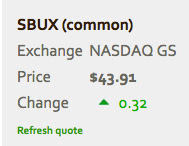Investor Relations:
By all
accounts, Starbucks appears to be doing everything right when it comes to investor
relations. The company comes across as extremely transparent, posting important
information in a variety of different places and formats, most notably their Webcasts
& Presentations.
 The site also includes sections for Recent
Financial and News Announcements; a complete list of the firms
currently providing research coverage on Starbucks; financial
Annual
Reports dating back to 1999 (there is a separate
Social Responsibility report); a list of their Board
of Directors and Senior
Officers; governance
principles, committee charters and policies; an up-to-date Event
Calendar that highlights upcoming conference calls and other
scheduled announcements and presentations; Financial
Highlights including Reconciliations, Store Counts, and Supplemental Data; First
Call Estimates; 21 different Investor
Frequently Asked Questions; SEC
Filings; Stock
Information; there is even a section that responds to recent rumors
about Starbucks.
The site also includes sections for Recent
Financial and News Announcements; a complete list of the firms
currently providing research coverage on Starbucks; financial
Annual
Reports dating back to 1999 (there is a separate
Social Responsibility report); a list of their Board
of Directors and Senior
Officers; governance
principles, committee charters and policies; an up-to-date Event
Calendar that highlights upcoming conference calls and other
scheduled announcements and presentations; Financial
Highlights including Reconciliations, Store Counts, and Supplemental Data; First
Call Estimates; 21 different Investor
Frequently Asked Questions; SEC
Filings; Stock
Information; there is even a section that responds to recent rumors
about Starbucks.
My
only criticism of the site is that there
is so much information. While I don’t think this is necessarily a bad
thing, it would be nice to have a page that provides the main facts and figures
– just the highlights so that I don’t need to click through all of the
different sections to find what I need. They do have an Overview page, which I
think was intended for this, however, I don’t think it is used most
effectively. Having such a page would certainly help in a crisis. I would
suspect that a great deal of the information within the investor relations
section does not need to be updated more than a few times a year. Using the
Overview page more effectively would enable them to highlight the most recent
and news worthy information for regular visitors to gather.
Government
Relations:
Of course a company as large as Starbucks
could not exist without ever having to deal with the government. Given the
locations that Starbucks grows and purchases beans from, they must deal with
governments on a daily basis.
According to OpenSecrets.org,
Starbucks does direct funds toward lobbying for the food and beverage industry.
In my opinion it is quite low in comparison to many other companies of its size
- $460,000 (2011), $730,000 (2010), $530,000 (2009),
and $638,000 (2008).
However, what I found more interesting than the above, is Starbucks’ and
Howard Schultz’s most recent “political” campaign.
This past fall Schultz wrote in an open letter, “ I
asked fellow business leaders to join me in urging the President and the
Congress to put an end to partisan gridlock and, in its place, to set in motion
an upward spiral of confidence…First, to withhold political campaign
contributions until a transparent, comprehensive, bipartisan debt-and-deficit
package is reached that honestly, and fairly, sets America on a path to
long-term financial health and security. Second, to
do all we can to break the cycle of economic uncertainty that grips our country
by committing to accelerate investment in jobs and hiring.”
When so many people cow-tail to the government
in order to stay in favor, I think it is extremely gutsy for a company and CEO
of his caliber to stand up and speak out publicly on such a sensitive issue.
Corporate
Social Responsibility:
 |
| Visit the Starbucks site to see how you can mane a difference |
As with Investor Relations, Starbucks’
Corporate Social Responsibility (CSR) relations is impressive. In fact, there
is simply too much to talk about in this short blog. However, an entire
sub-section of their website
is dedicated to their five pillars - Community Involvement, Ethical Sourcing,
Environmental Stewardship, Wellness and Diversity - for anyone who is
interested in learning more. The site allows you to learn more about the
different initiatives, read their Shared
Values blog, review their progress
toward set goals, and how
you can make a difference.
Because most of their corporate controversy
has centered around their social responsibility, specifically the way they
acquire their beans and treat local farmers, I would suggest that they link
their section on rumors to this page so that readers can quickly learn Starbucks’
“side of the story”. I would also recommend adding this section to their
Facebook page, as people are more likely to visit this than the corporate website.
This would also allow them to post accurate information quickly in the event of
a crisis.
Being able to communicate accurate
information as quickly as possible, on many different forums and in a variety
of ways is most important in today’s technological age.



